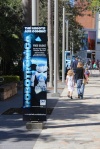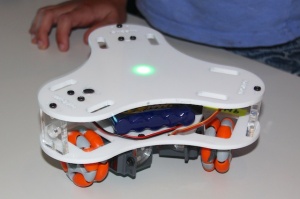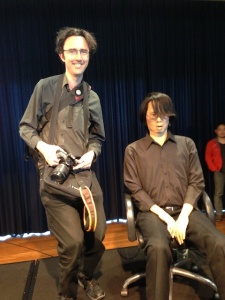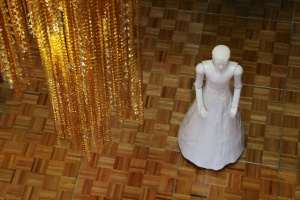Eye machines: Robot eye, vision and gaze article published
The International Journal of Social Robotics has published the article Fiona Andreallo and I wrote on the three dimensions of eye machines: the eye itself, the operation of vision, and the intersubjective significance of the gaze. You can read it here.
Abstract
This article analyses three aspects of human and robotic eyes: 1) the eye as an object that evokes visceral reactions from observers when it is exposed or threatened; 2) the eye and brain, sensor and computer as mediators of vision and interpreters of visual worlds; and 3) the gaze as a mode of communication in interpersonal/human-robot interaction. Taking an interdisciplinary approach, this article draws on neuroscience, human-robot interaction, critical humanities, feminism and film studies to interrogate these three aspects of eyes as they relate to the design, theorisation and experience of social robots. We argue that some of the meanings and imaginaries associated with biological eyes are transferred and translated into robotic eyes, vision and gaze, or eye machines, following the tendency towards anthropomorphism. These imaginaries are made visible particularly in science fiction. We argue that photography, the cinematic apparatus, digital sensors and artificial intelligence are not only engineering innovations but have also contributed to transformations in the contemporary collective visual world. Our multimethod cultural studies analysis of eye machines has relevance for cultural theorists, designers and engineers.
Philosopher of media and technology, Mark Coeckelbergh visits Sydney
Mark Coeckelbergh, Professor of Media and Technology at the University of Vienna visited Sydney in November/December 2019. He presented at a Sydney Ideas event ‘Wild AI and tame humans‘ on November 18, and led two research workshops. He has written a number of articles on philosophy and robotics, including ‘Humans, animals, and robots: A phenomenological approach to human-robot relations‘ and ‘You, robot: on the linguistic construction of artificial others‘ in AI and Society.
In the video below I interviewed him about three of his books: Moved by machines: Performance metaphors and philosophy of technology, New romantic cyborgs: romanticism, information technology, and the end of the machine and Using words and things: Language and philosophy of technology.
The visit was supported by the Sydney Institute for Robotics and Intelligent Systems, The Sydney Social Science and Humanities Advanced Research Centre, and the Sociotechnical futures lab.
Talking about the robot gaze
How does it feel when a robot looks you in the eye? In July Michael Garbutt and I recorded a conversation on the robot gaze (following our chat in May about invocational media). The possibility of a robot gaze exposes the ambiguity over the status of the robot as a being or a thing. If it is capable of a gaze, then it has some level of agency in constituting the subjectivity of those present, whether or not it is itself sentient. This is surely the geopsychological foundations of the uncanny valley: the sense of presence, or co-presence of something that looks back. This inscrutable perceiving entity may seem to deliver Lacan’s (1979) castrating gaze, Sartre’s (1984) shaming gaze, or Foucault’s (1975) examining gaze, and possibly without any referral to a human gaze at all.
This discussion came out of a paper that Fiona Andreallo and I wrote on the robot eye, vision and gaze, and I presented at the Beyond Anthropomorphism symposium at the University of Sydney, and presented in a new form at the International Association of Media and Communication Research conference in Madrid.
Foucault, M. (1975). The birth of the clinic: An archaeology of medical perception. New York: Vintage Books.
Lacan, Jacques (1979 [1964]) The Four Fundamental Concepts of Psychoanalysis, trans. Alan Sheridan, London: Penguin.
Sartre, Jean-Paul (1984) Being and Nothingness. Trans. Hazel E. Barnes. New York: Washington Square Press.
Beyond anthropomorphism symposium
I am helping to organise a symposium with the Sydney Institute for Robotics and Intelligent Systems called ‘Beyond Anthropomorphism: Rethinking Human-Machine Relations in Robotics and AI‘ on June 11 and 12, 2019. We have three international speakers and a full day of papers on this theme.
Toy robots on YouTube: Consumption and peer production at the robotic moment
I recently published an article on the representation of Furbies and other toy robots on YouTube. My own version is available from Academia.edu.
Here is the abstract:
Robots are increasingly prominent in the popular imagination, partly through people playing with toys and using social media. This article examines a selection of user-created YouTube videos in different genres that reveal how people experiment with toy robots such as the Furby. These devices have features that support different styles of play, which producers of YouTube clips explore in short narratives. They reveal how the intersubjective conventions for relating to robots are currently being developed. YouTube stars produce vlogs (video blogs) telling stories about their search for Furbys, unboxing them, and experimenting with the toy’s playful and uncanny features. Set-piece video producers experiment with how Furbys interact with others, such as trying to communicate, confronting family pets or being destroyed with weapons. Being ‘almost alive’, toy robots are harbingers of autonomous technologies that have social agency.
Robowars at Vivid
Robowars competitors show off their jumping talents.
Mining robotics and media change
Here’s a link to an article I wrote last year on the transformations in mining practices associated with digital technologies. In it I argue that changes even in such a large scale material practice can be considered as media changes.
Autonomous Robots compete to beat the field
The meaning of individual robots is put into relief when they face competition. This week I watched the National Instruments (NI) Autonomous Robotics Competition finals at Macquarie University as 27 teams placed their robots onto the playing field in the Lotus Theatre.
The agonistic framing of the competition makes the more capable robots (including two from UNSW who took the top spots) stand out. The weaker robots that failed to start, or got stuck or lost on the course, point to how challenging the task is. The ritual of competition blesses the robots as participating in a higher calling. Judges circulate. An MC commentates. A DJ plays motivational music. The competitors watch nervously as their autonomous charges face their fate alone on the field.
The teams of engineering and mechatronics students had built their robots from a standard platform from sponsor National Instruments. But their robots took many shapes: some more polished space-ship shapes; others jerry-rigged with sticky tape, and another more quirky entry with a toy dog driver and flashing lights on the back (see video). The team with this robot stood out in their colourful headgear.
The robots had to complete on an agriculturally themed course, with the brief ‘Go, Sow, Grow’. They set off from a home square, crossing diagonally to load up some ‘seeds’ (red foam cubes) into a holding bay on the robot’s back. From here, they found their way onto the ‘field’, placed the seeds on darkened furrows, and returned home. In the later rounds the robots had to dodge randomly placed pot-plants, and drop a larger number of seeds.
Of course the theme was pointedly directed towards one of the domains of innovation in contemporary robotics: agricultural applications. These applications have been most notably addressed by the Australian Centre for Field Robotics. The competition has the ideological function of proselytising this field of robotics. In miniaturising the dynamics of this field, the competition legitimises the broader prospects of agricultural robotics.
Google’s robot challenge
Rise of the Google machines: the robotics companies involved
[First published in The Conversation, January 8, 2014]
By Chris Chesher, University of Sydney
Google recently acquired eight high profile start-up robotics companies, providing strong evidence of a strategy to create breakthrough applications for robotics over the next decade. This strategy is most likely to concentrate on manufacturing and logistics.
Bringing these companies together, Google will need to find synergies between diverse organisations and personalities. This mission will be headed by Andy Rubin, who previously managed the successful Android operating system for mobile devices.
Rubin describes Google’s highly ambitious goal of finding technically and economically viable applications for robotics as a “moon shot”: a highly concentrated effort of an integrated team to create landmark achievements in a field. The mission to put a man on the moon is one clear precedent.
There are many other possible analogies for Google’s robot “moon shot”. Journalist Tom Green, writing in Robotics Business Review, compares Google’s contribution to the robotics industry to the US Defense Advanced Research Projects Agency’s (DARPA) pivotal role in establishing the founding technologies of the internet.
Google’s project might also be compared with Atari research lab, formed in the 1970s to generate innovations in computer game and entertainment technologies. (Unfortunately this did not prevent the massive failure of the company in the mid-1980s.)
An even less appealing analogy is the Manhattan Project that created the atomic bomb in the 1940s. Considering the role of the US military in funding and fostering robotics research, the parallel is not so far off.
Xerox PARC is another corporate that has been highly successful in innovating in the domain of office technologies, but is known most for its failure to transfer research prototypes to viable products.
In expanding Google’s investments in robotics, Rubin will face the challenge of integrating the companies that form Google’s moon shot at Palo Alto, California. What is notable about many of these companies is they are either interdisciplinary in orientation, or highly specialised.
Many of the companies began as spin-offs from university robotics research. The companies that had a spin-off culture will need to transition into being part of a large organisation, with the politics that this entails.
So who has Google bought and what do they do?
Bot & Dolly
Bot & Dolly is largely a product of the film industry, creating robotic systems to control cameras in movies such as Gravity.
This film included sequences that began as computer-generated imagery, which was matched with live action sequences using robotic cameras. In the clip below, robot cameras captured the astronaut’s faces as they spun around in zero gravity.
These images were mapped into the computer-generated sequence. Experimenting at the intersections of cinema, robotics and stage magic, Bot & Dolly produced a stunning performance piece called Box.
Box uses two robots to manipulate screens onto which high definition projectors present geometrical and op-art inspired patterns. A human performer interacts with the screen images, creating a seamless hybrid of multiple disciplines.
Autofuss
Bot & Dolly’s design studio arm Autofuss emphasises its collaborative approach “colliding visual artists with programmers, engineers with designers, storytellers with illustrators, architects with machinists”.
It has produced promotional videos for Google, Microsoft and Adobe. These promotions make heavy use of robotic cameras, motion design, animation and live action production.
Meka Robotics
Meka is another university spin-off company, coming out of the Massachusetts Institute of Technology Computer Science and Artificial Intelligence Laboratory in 2006. One of their aims is to create highly agile robots that can run quickly over uneven ground.
Holomni
Holomni is a design firm that specialises in highly controllable caster wheels that can position robots with 360 degree precision. Such a specialised company is likely to produce devices that slot well into any robot that needs precise mobility.
Redwood Robotics
Redwood Robotics is a Silicon Valley company specialising in robotics arms. It is a 2012 spin-off from Meka Robotics, Willow Garage and SRI International, and aims to create a:
“new generation arm” for robots […] that does for robotics what the Apple II did for computers: get the hardware out of factories and into homes.
Like Holomni, the strategy is the concentrate on one particular component that can be used in a variety of robot applications. Whether Google will pursue this goal of providing wheels and arms to the wider industry, or not, it not yet clear.
Industrial Perception
A spin-off from high profile robotics company Willow Garage, Industrial Perception Inc produces 3D visual perception systems for applications such as unloading trucks and feeding parts.
They aimed to produce product-level robots that could work at a level and speed comparable to humans unloading trucks (see Casey Nobile’s article in Robotics Business Review). Industrial Perception’s goals seem in line with Google’s goals with their move into robotics.
Boston Dynamics
Boston Dynamics has achieved a high profile for its robotics projects by posting popular videos of its intimidating robots Big Dog, Cheetah and PETMan.
Their projects have been funded by the US Defense Advanced Research Projects Agency (DARPA).
Boston Dynamics was founded in 1992 by Marc Raibert, a former professor at the Massachusetts Institute of Technology. It was the eighth and last of the companies to join Google so far.
Schaft
Schaft is a Japanese engineering company that spun off from the University of Tokyo. It recently won the DARPA Robotics Challenge, a competition for robotic performance funded and supported by DARPA.
The goal of the competition was to complete tasks to a rescue robot that could drive a vehicle, walk on uneven ground, walk up an industrial ladder, clear debris, open a door, cut through a wall, open a valve and use a hose. The only non-US competitor, Schaft’s robot scored 27 out of 32 points and beat the Boston Dynamics team by some margin.
Robot cultures
The Googlefication of robotics research is likely to represent something of a cultural shift for the organisations and employees involved. However, there are common stories for many of the companies. The grounding of much of the research in universities is one clear shared experience.
Each of the companies above has highly specialised applications and well-formed visions. Google wisely selected companies on the basis of some firm instrumental orientation and corporate vision.
In spite of the growing investments in robotics, longer term questions about the future models for robotics in everyday life remain open. How key components — from machine vision to directional wheels, from automated cameras to humanoid rescue robots — might combine into transformative applications is yet to be seen.
Also yet to be known is the impact of Google’s taking cream from the top of a still-young robotics industry.
Chris Chesher writes a blog on the cultural aspects of robotics: Following Robots.
Chris Chesher does not work for, consult to, own shares in or receive funding from any company or organisation that would benefit from this article, and has no relevant affiliations.
![]()
This article was originally published at The Conversation.
Read the original article.
Robotronica
An event such as Robotronica, in Brisbane on the 18th of August 2013, reveals how popular robots are with the general public. QUT’s new Science and Engineering Centre was packed with curious families, shuffling from exhibition to demonstration.
Ars Electronica presented an overview of development of the Linz, Austria new media arts centre. They previewed the ‘Spaxels’ performance that would occur later in the evening. Spaxels are moving pixels in space, formed from thirty quadcopter drones with script-controlled lights.
I chose to go to some demos including Paro, a well-known seal-shaped robot used with dementia patients. The way it moves and engages with those around it do seem to make it more than a cuddly toy. Currently in its eighth generation, Paro can sense touch, light, sound, temperature and posture. Each Paro has its own name.
Cheap and cheerful
Another demo was a new robot called the Weaver, a simple three-wheeled, wifi connected vehicle that aspires to be a very economical introduction to robotic principles. The hardware includes a sensors for distance, light, temperature, rotation, microphone and speaker and compass. It features an 8×8 LED matrix and a lamp. Its wheels can turn in any direction. The developers are planning to put the project into Kickstarter within months.
Nao and then
The Nao robot was also there, although the one that I was watching was not working. This happened to me once before, when I first saw the Nao in Korea that had a broken leg. Nao seems somewhat fragile. I understand that faulty robots need to be returned to France for repair. Still, the Nao is an impressive little humanoid.
Uncanny lecturer
I went to the talk by Hiroshi Ishiguro. He was in Japan, but his dopelganger, the Geminoid android, was able to give body to his voice. While there was no sense in which the Gemonoid was indistinguishable from the human speaker, it did serve as a focus of attention. There was a kind of fetish value to the android that attracted people at the end of the talk (including me).
In question time it became clear he had a sense of humour. When asked about how he travelled, he said that his head was in the hand luggage, and his body and legs travelled as checked luggage.
It is apparent that Ishiguro has aspirations for his research to become pragmatically valuable, and not simply art practice.
The Diamandini Age
In Old Government House, David and David were trying to get the porcelain-like robot
Diamandini to function properly again. While some visitors were frustrated by her lack of responsiveness, she served quite well as a sculpture until she was back in action. When I returned, she was working — gliding around the parquet floor, underneath the elegant chandelier. She sometimes seemed to be attracted to visitors, while at other times she was repelled.
Finally, I waited for the closing performance by the Spaxels, hosted by Geminoid HI-4, with music by 8-bit hero. The formation of quadcopters appeared in the sky, like some miniature choppers from Apocalypse Now. It was an experimental demonstration of possibilities for multiple quadcopters. Apparently this performance was the first in which the computers running the scripts were on-board the vehicles, rather than remotely operated.
Robotronica was a great success, with many visitors, and a wide array of robots on display.




